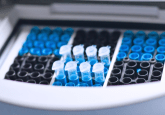Perspectives on the ICH M10 guidance and its impact on the regulatory landscape for chromatographic assays

Jennifer Zimmer, PhD, Alturas Analytics, Inc., (ID, USA)
Dr Jennifer Zimmer is the Laboratory Director at Alturas Analytics, Inc. (ID, USA) and has been working in the field of bioanalysis for over 20 years. She received her BA degree in English and Zoology from the University of Idaho (ID, USA) and her PhD in Pharmacology from the University of Colorado Health Sciences Center (CO, USA), working in Dr Robert Murphy’s laboratory on the leukotriene lipid mediator pathway. Her post-doctoral experience in Dr Richard Smith’s laboratory focused on using metabolomics to elucidate disease pathways and to discover novel biomarker targets.
Dr Zimmer is responsible for the overall operation of the Alturas Analytics laboratory. She has experience with FTICR, TOF, ion trap and quadrupole instrumentation. She has utilized these instruments for quantitation as well as structure elucidation using HPLC-MS/MS and HPLC-MSn. She oversees the scientific staff and ensures that client deliverables are met while working laterally with the Alturas Analytics, Inc. Quality Assurance Unit to maintain laboratory compliance with all procedures and regulations. Dr Zimmer is an active participant the Global CRO Council (GCC) and a member of the American Society for Mass Spectrometry.
Introduction
The ICH (International Council for Harmonisation of Technical Requirements for Pharmaceuticals for Human Use (Geneva, Switzerland)) formed a working group in 2016 to address growing concern in the industry that the guidances and regulations for bioanalytical method validation and sample analysis in individual countries/regions were becoming disparate. With the release of the final version of ICH M10 in May 2022 (1), harmonization of the requirements for bioanalytical method validation and sample analysis comes closer to a reality and is now just pending adoption by the regulatory authorities in regions around the globe. As each member country adopts the M10 guidance, it will replace any earlier country-specific guidance, allowing bioanalytical labs to follow the same analysis and reporting guidelines regardless of where the bioanalytical data will be submitted.
Although recent guidances from the FDA (2), EMA (3), Japan (4) and other regulatory bodies have been mostly consistent, there were subtle differences between the requirements. For the past few years at Alturas Analytics, we have written our SOPs to follow the 2018 FDA Bioanalytical Method Validation Guidance for Industry (2), the 2011 EMA Guideline on Bioanalytical Method Validation (3) and other relevant white papers. The recent adoption of ICH M10 by the EMA, effective 21 Jan 2023, will require some changes to lab procedures as well as some changes in reporting. In this column, a summary of our thoughts on the most pertinent changes for chromatographic assays will be presented.
Method Development
There are few changes to standard industry practices of method development when comparing the M10 guidance to recent guidances from the FDA, EMA and others. However, method development is more extensively described in the ICH M10, and the guidance makes it clear that bioanalytical method development does not require “extensive record keeping or notation.” (1). The M10 guidance also describes the requirement to increase the level of documentation when making changes to an already validated assay, which has been commonly communicated verbally by regulators over the past several years. One item of interest is listed in the method validation specificity section. The requirement to assess the extent of back-conversion of unstable metabolites has been specifically called out during validation, with a requirement to partially validate the impact of this possible back-conversion and discuss any impact on study results in the bioanalytical report. From our perspective, this assessment should be well characterized prior to starting validation so that any impact could be minimized or eliminated.
Validation
For the most part, the validation section of the M10 guidance is consistent with the FDA and EMA guidances. There are several notable additions, however. The first notable item is a specific descriptor about how the mid-level QC (MQC) should be set. Previously, the guidance required a ‘mid-range’ MQC and in the Crystal City III white paper (5), the geometric mean of the range was recommended, which allows the detection of variability at the lower end of the calibration range. The M10 guidance requires the MQC to be set at 30-50% of the ULOQ, which may be appropriate for fixed dose bioequivalence studies, but may not be the best measure of variability for earlier pre-clinical or clinical dose escalation studies. Another change to QC concentrations is the explicit expectation that dilution QCs be tested at bracketing dilution factors for the dilution factors expected during sample analysis. This may require multiple concentrations of greater than ULOQ QC to be tested for dilution linearity so that the bracketing dilution factors will bring the QC concentration within the calibration curve range.
Another notable change from the FDA guidance is the specific inclusion of a section on reinjection reproducibility. The new requirements indicate that reinjection reproducibility should be demonstrated to cover the amount of time that transpires between extraction and injection of incurred samples. While performing this experiment has become routine over the last several years due to the informal regulatory requirement for the experiment, the FDA and EMA bioanalytical guidances did not have a specific written requirement for reinjection reproducibility. The specific instructions in the M10 guidance will ensure consistency across the industry for how this experiment is performed.
The inclusion in the ICH M10 guidance of specific statistical methods such as Bland-Altman plots or Deming regression for determining concordance between two separately validated methods for cross validations is a change from the EMA guidance, which references using ISR criteria for the comparison of sample values when measured by the two validated methods. This change makes sense because the ultimate goal should be to determine the bias between the methods rather than holding each method to specific criteria.
The ICH M10 guidance also specifically calls for benchtop, freeze-thaw and long-term stability of fixed-dose and specifically labeled drug regimens. This is a clarification from the current FDA guidance, which just calls for stability testing.
Finally, there are several changes to how reference and internal standards should be handled in the ICH M10 guidance. First, the guidance specifically recognizes that the stability of the analyte/internal standard in solution is separately determined from the stability of the neat compound (as determined on the certificate of analysis). Secondly, if the internal standard is not a stable label internal standard in the same solvent as the reference standard, then both long-term and short-term stability at bracketing concentrations must be proven for the internal standard. This may be a change for many who have only proven short-term stability and ongoing suitability for their internal standard solutions.
Sample Analysis
In the sample analysis section, ICH M10 is fairly consistent with the FDA, EMA and other recent guidances. Two changes stood out when reviewing this section. First, is the statement that “study samples should always be bracketed by QCs” (1). It has been common industry practice to bracket all samples by spiked samples with a known nominal concentration. However, it seems to be general practice to bracket incurred samples with either QC samples or calibrators. Now it appears that only QC samples must be used for this purpose.
The second change is the requirement that the concentration of the dilution QCs included in each batch of sample analysis exceed that of the study samples being measured, or at a minimum, exceed the ULOQ. Standard industry practice seems to be to either exclude dilution QCs altogether during sample analysis because dilution linearity was proven during validation or to include them and use a within-range QC (e.g., the high QC level) to demonstrate that there are no gross errors in the process of dilution within the batch. In addition to the expectation that the dilution QC be above the calibration range during sample analysis, the ICH M10 guidance also explicitly requires that the dilution factors used within each batch be bracketed by the dilution factors applied to the above-range dilution QC. In our opinion, this seems to be an excessively conservative approach to proving the validity of all dilutions during sample analysis.
Reporting
The majority of changes to standard industry practices appear to be in the reporting requirements set forth by the M10 guidance. Many of the changes appear to be aimed at allowing the reviewers to have access to much more source data at the time of report review. One example of additional information that is now requested in reports is a new requirement to include not just a standard re-assay table, but also a summary table of the reasons samples are reanalyzed and the number of samples reanalyzed for each reason. Other examples include a request that “QCs graphs trend analysis encouraged” (1) to be included in the bioanalytical sample analysis report and, for comparative bioavailability (BA) and bioequivalence (BE) studies, the requirement for the inclusion of internal standard response plots for all runs, including failed runs. If samples are reintegrated in a study, extensive documentation must be provided to support this reintegration, with requirements for inclusion of the “reason for reintegration, identification and discussion of chromatograms with manual reintegration” (1), and the “SOP for reintegration” (1). For comparative BA/BE studies, the results before and after reintegration must also be reported.
In some cases, it is not quite clear what the regulators will expect to be included in the bioanalytical report. For example, in comparative bioavailability and bioequivalence studies, the M10 guidance asks that “a separate table should report values from rejected runs” (1). In this case, should batch acceptance values, such as calibrator and QC sample data be included, or is there now a requirement to report sample values from runs that have unacceptable standard curve or QCs? As meetings between industry and regulators take place over the next several months, hopefully more clarity will be provided for some of these issues.
Conclusion
The ICH M10 guidance is a welcome step into a standardized global set of requirements for bioanalytical method development, method validation, sample analysis and reporting. As more member countries adopt this guidance, it will provide drug applicants and their bioanalytical partners with a consistent set of expectations. While there will be some changes to standard practices as a result of this new guidance, in general, the ICH M10 guidance is very consistent with the expectations that regulators have set with previous regional guidances.
References
- Bioanalytical Method Validation and Study Sample Analysis, M10. International Council for Harmonisation of Technical Requirements for Pharmaceuticals for Human Use, https://database.ich.org/sites/default/files/M10_Guideline_Step4_2022_0524.pdf (2022)
- Bioanalytical method validation: Guidance for industry. Food and Drug Administration, www.fda.gov/files/drugs/published/Bioanalytical-Method-Validation-Guidance-for-Industry.pdf (2018)
- Guideline on Bioanalytical Method Validation. European Medicines Agency, www.ema.europa.eu/en/documents/scientific-guideline/guideline-bioanalytical-method-validation_en.pdf (2011)
- Guideline on Bioanalytical Method Validation in Pharmaceutical Development. Japanese Ministry of Health, Labour and Welfare, www.nihs.go.jp/drug/BMV/250913_BMV-GL_E.pdf (2013)
- Viswanathan, C. T., Bansal S, Booth B et al., Workshop/conference report – Quantitative bioanalytical methods validation and implementation: Best practices for chromatographic and ligand binding assays. AAPS Journal, 9(1), doi: 10.1208/aapsj0901004 (Epub 2007)
In association with:

Our expert opinion collection provides you with in-depth articles written by authors from across the field of bioanalysis. Our expert opinions are perfect for those wanting a comprehensive, written review of a topic or looking for perspective pieces from our regular contributors.
See an article that catches your eye? Read any of our Expert Opinions for free.





